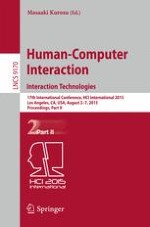The 3-volume set LNCS 9169, 9170, 9171 constitutes the refereed proceedings of the 17th International Conference on Human-Computer Interaction, HCII 2015, held in Los Angeles, CA, USA, in August 2015. The total of 1462 papers and 246 posters presented at the HCII 2015 conferences was carefully reviewed and selected from 4843 submissions. These papers address the latest research and development efforts and highlight the human aspects of design and use of computing systems. The papers in LNCS 9170 are organized in topical sections on gesture and eye-gaze based interaction; touch-based and haptic interaction; natural user interfaces; adaptive and personalized interfaces; distributed, migratory and multi-screen user interfaces; games and gamification; HCI in smart and intelligent environments.
